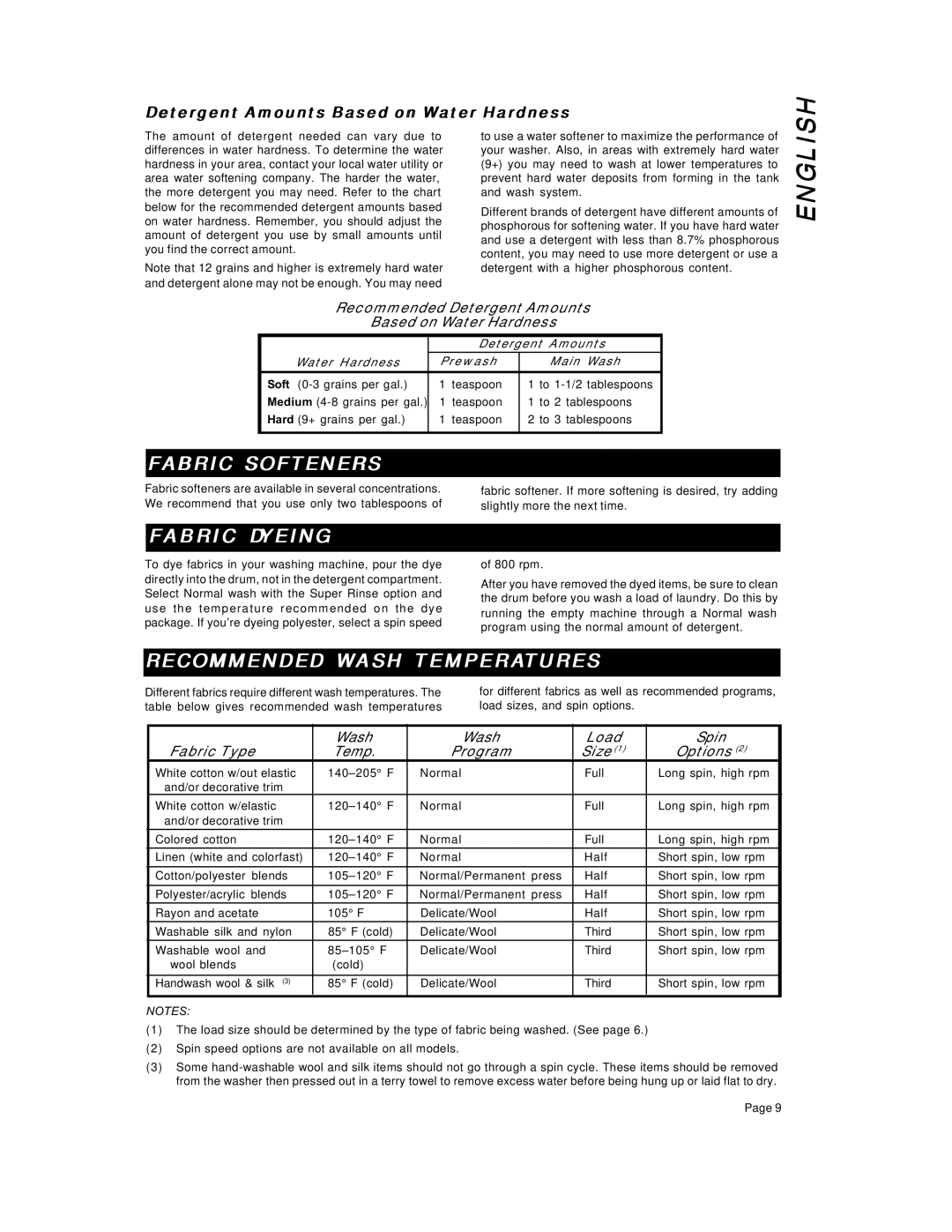
Detergent Amounts Based on Water Hardness
The amount of detergent needed can vary due to differences in water hardness. To determine the water hardness in your area, contact your local water utility or area water softening company. The harder the water, the more detergent you may need. Refer to the chart below for the recommended detergent amounts based on water hardness. Remember, you should adjust the amount of detergent you use by small amounts until you find the correct amount.
Note that 12 grains and higher is extremely hard water and detergent alone may not be enough. You may need
to use a water softener to maximize the performance of your washer. Also, in areas with extremely hard water (9+) you may need to wash at lower temperatures to prevent hard water deposits from forming in the tank and wash system.
Different brands of detergent have different amounts of phosphorous for softening water. If you have hard water and use a detergent with less than 8.7% phosphorous content, you may need to use more detergent or use a detergent with a higher phosphorous content.
ENGLISH
Recommended Detergent Amounts
Based on Water Hardness
|
| Detergent Amounts | |||
Water Hardness | Prewash |
| Main Wash | ||
Soft | 1 | teaspoon | 1 | to | |
Medium | 1 | teaspoon | 1 | to 2 | tablespoons |
Hard (9+ grains per gal.) | 1 | teaspoon | 2 | to 3 | tablespoons |
|
|
|
|
|
|
FABRIC SOFTENERS
Fabric softeners are available in several concentrations. | fabric softener. If more softening is desired, try adding |
We recommend that you use only two tablespoons of | slightly more the next time. |
FABRIC DYEING
To dye fabrics in your washing machine, pour the dye directly into the drum, not in the detergent compartment. Select Normal wash with the Super Rinse option and use the temperature recommended on the dye package. If you’re dyeing polyester, select a spin speed
of 800 rpm.
After you have removed the dyed items, be sure to clean the drum before you wash a load of laundry. Do this by running the empty machine through a Normal wash program using the normal amount of detergent.
RECOMMENDED WASH TEMPERATURES
Different fabrics require different wash temperatures. The table below gives recommended wash temperatures
for different fabrics as well as recommended programs, load sizes, and spin options.
Fabric Type | Wash | Wash | Load | Spin |
|
Temp. | Program | Size (1) | Options (2) |
| |
White cotton w/out elastic | Normal | Full | Long spin, high rpm |
| |
and/or decorative trim |
|
|
|
|
|
White cotton w/elastic | Normal | Full | Long spin, high rpm |
| |
and/or decorative trim |
|
|
|
|
|
Colored cotton | Normal | Full | Long spin, high rpm |
| |
Linen (white and colorfast) | Normal | Half | Short spin, low rpm |
| |
Cotton/polyester blends | Normal/Permanent press | Half | Short spin, low rpm |
| |
Polyester/acrylic blends | Normal/Permanent press | Half | Short spin, low rpm |
| |
Rayon and acetate | 105° F | Delicate/Wool | Half | Short spin, low rpm |
|
Washable silk and nylon | 85° F (cold) | Delicate/Wool | Third | Short spin, low rpm |
|
Washable wool and | Delicate/Wool | Third | Short spin, low rpm |
| |
wool blends | (cold) |
|
|
|
|
Handwash wool & silk (3) | 85° F (cold) | Delicate/Wool | Third | Short spin, low rpm |
|
|
|
|
|
|
|
NOTES:
(1)The load size should be determined by the type of fabric being washed. (See page 6.)
(2)Spin speed options are not available on all models.
(3)Some
Page 9
